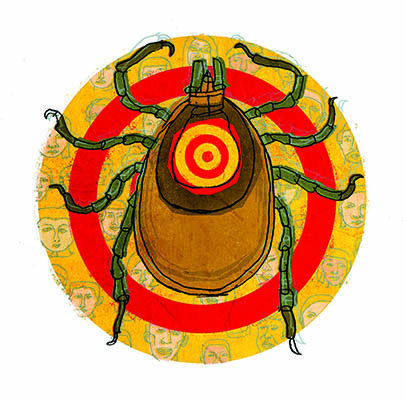Scientists at Calibr have created a unique strategy for preventing Lyme disease— an approach that involves repurposing a powerful molecule currently used for pets

Lyme disease is already the most widespread tick-borne infection, but it’s becoming even more problematic as tick populations boom across the United States. Notorious in the Northeast, where it’s still rampant, Lyme now spans the country.
For those bitten by a deer tick, a characteristic red “bulls-eye” rash is often the first sign of trouble. Symptoms can then evolve into fever, headache and fatigue.
Fortunately, people who realize they’ve contracted the bacterial infection can usually clear up symptoms completely with a regimen of antibiotics. But if it’s not caught right away, Lyme can lead to painful, long-term effects as it spreads to joints, the heart and the nervous system.
“There are a lot of great ways for people to protect themselves from ticks,” says Arnab Chatterjee, PhD, vice president of medicinal chemistry at Calibr, the drug development arm of Scripps Research. “But nothing is foolproof.”
At least nothing yet. Chatterjee is leading efforts to create a new long-acting oral medicine that may be able to stop the spread of Lyme. The drug, based on a discovery at Calibr, relies on a potent class of molecules known as isoxazolines that are already used in medicines for companion animals. The idea is that people could take the medicine once before tick season and it would remain active in the body for up to several months, killing any tick that attempts to draw blood.
Importantly, Chatterjee says, ticks would perish before they have a chance to transmit the Borrelia burgdorferi bacteria that causes Lyme.
“That’s the real power of this approach,” says Chatterjee, who refers to the medicine as a chemical vaccine. “It could prevent people from contracting Lyme disease, while also significantly reducing the tick population. So, you would realize a health benefit not only among those who take the drug, but for everyone else in the family and community.”
Chatterjee and his team at Calibr are now optimizing drug candidates to ensure they are as safe and effective as possible before human testing begins. He expects the first clinical trial to kick off in late 2020 or early 2021. Though Lyme disease is the top priority, Calibr plans to explore the drug’s efficacy against other tick-borne and mosquito-borne illnesses.

Combating Lyme: An urgent need
- In 2018, state and local health departments reported a record number of cases of tick- borne diseases to the Centers for Disease Control and Prevention. Though more than 60,000 cases of Lyme disease were reported, thousands more likely occurred.
- The number of U.S. counties with blacklegged ticks (also known as deer ticks), which are responsible for most cases of Lyme disease, more than doubled over the past 20 years.
- Ticks are tiny and abundant in grassy or wooded areas where they feed on white-footed mice, which carry the disease-causing bacteria.
- Lyme disease can be hard to detect, and traditional preventative measures—bug spray, long pants, tick checks—can only go so far.